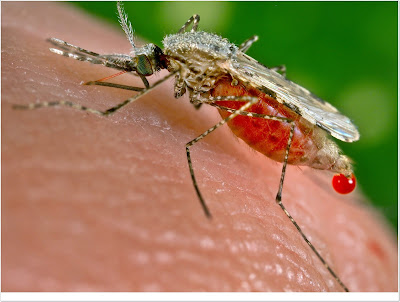 |
| The dangers of malaria mosquitoes, their causes, life cycle, and spread |
The Dangers of Malaria Mosquitoes
Malaria mosquitoes are parasitic infectious diseases caused by plasmodium that attack erythrocytes and are characterized along with the discovery of asexual forms in the blood. Malaria infection develops symptoms in the form of fever, chills, anemia, and splenomegaly. Infectious diseases are too dominant in tropical and sub-tropical areas or tropical areas that are common but if ignored can be a serious disease. Malaria-causing parasites such as malaria type Plasmodium falciparum is tropical malaria that often results in death. It is a protozoan transferred to humans through the bite of a female Anopheles mosquito, especially at sunrise and sunset. At least 270 million of the world's population suffers from malaria and more than 2 billion or 42% of the world's population is at risk of malaria.
Who noted that every year not enough of the 1 to 2 million people die from diseases spread by the Anopheles mosquito. Malaria is also capable of caused by environmental changes more or less like the presence of world warming that occurs while this results in the spread of parasitic diseases transmitted through mosquitoes and other insects added to the heat. Changes in temperature, humidity, and extreme rainfall result in mosquitoes laying eggs more often so vectors as a contagion of diseases are added and as a result of various diseases, including dengue fever and malaria.
Causes of Malaria
Malaria is caused by the seeds of diseases that live in human blood. The following disease seeds are also single-celled animals, classified as amoeba called Plasmodium. The work of plasmodium is to cause damage to red blood cells. Through the intermediary of anopheles mosquitoes, plasodium enters the human blood and multiplies along with cleavage. There are four types of plasmodium that cause malaria:
A. Falciparum, the cause of tropical malaria. This type of malaria is capable of inviting death.
B. Vivax, the cause of tersiana malaria. The disease is difficult to cure and difficult to relapse.
c. Malaria, the cause of quartana malaria.
d. Ovale, the cause of Malaria Ovale.
Malaria life cycle
 |
| Malaria life cycle |
a. Asexual Cycles In The Human Body
- Cycle beyond red blood cells
The cycle outside the red blood cells (exothrmrositer) occurs in the liver. This stage is beginning while female anopheles mosquitoes bite humans and insert sporozoites found in their saliva into human blood. A few minutes later (0.5-1 hour) the sporozoite arrives in the liver and infects the liver. In the liver, sporozoites undergo asexual reproduction (schizophrenia) or cleavage system and produce child parasites (merozoites) that will then be removed from liver cells. In plasmodium vivax and Plasmodium ovale are found in a latent form in the liver called hypnosis, which is a phase of the life of malaria parasites that will be able to cause relapse/recurrence (long term relapse). P.vivax is able to relapse several times to a temporary period of 3-4 years while P. Ovale until many years unless not in the drug together well.
- Cycles in red blood cells
The cycle in the blood is beginning along with the release of merozoite from the mature skizon in the liver to circulation. The cycle in red blood cells (erythrositer) is divided into cystophilic cycles that invite fever and gametogoni cycles that result in a person becoming a source of transmission for mosquitoes.
b. Sexual Cycle In Mosquito Body
Gametocytes mature in the blood of patients who are sucked by mosquitoes will experience maturation into gametes (gametogenesis) while malaria parasites in the form of trophozoites, schizonts, merozoites are digested in the stomach of mosquitoes. Microgametocytes divide into 4-8 microgametes (male gametes) and macro gametocytes undergo maturity so macrogametes (female gametes). Then fertilization occurs in microgametes and macrogametes called zygotes. At first, it is round then switched so elongated and able to move and called ookinete. Ookinet penetrates the stomach wall and becomes a round shape called ookista. Ookista added a lot of time and in it the core is divided and each nucleus is covered with protoplasm and has an elongated shape (10-15 microns) called sporozoite. Ookista will rupture and thousands of sporozoites will be released inside the mosquito cavity which will then reach the salivary glands. Female anopheles mosquitoes are ready to transmit malaria. The principle of malaria eradication in others is based on this cycle, namely along with trying to age mosquitoes shorter than the extrinsic incubation era so that the sporogony cycle (because it produces sporozoites) is not able to take place.
Plasmodium life cycle
The life cycle of plasmodium parasites occurs in the human body and female Anopheles mosquitoes. There are two life cycles of plasmodium in the breed, namely the sporogony (sexual) and schizogony (asexual) cycles
source:
http://id.wikipedia.org/wiki/Malaria
http://id.wikipedia.org/wiki/Plasmodium_falciparum
http://id.wikipedia.org/wiki/Plasmodium






Post a Comment
Post a Comment